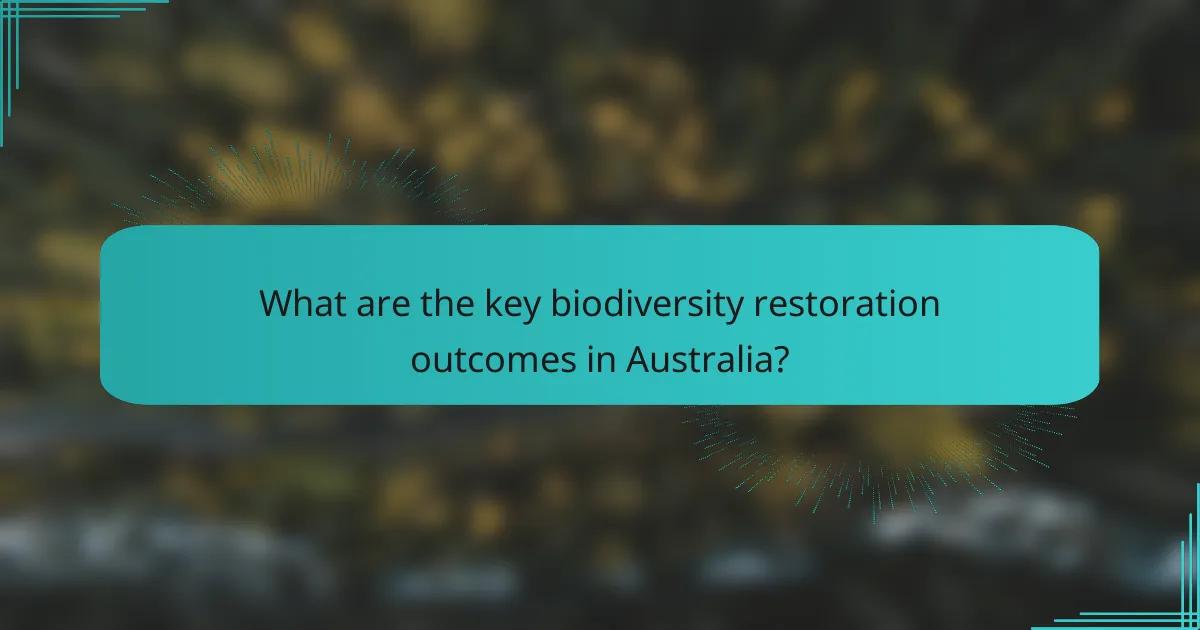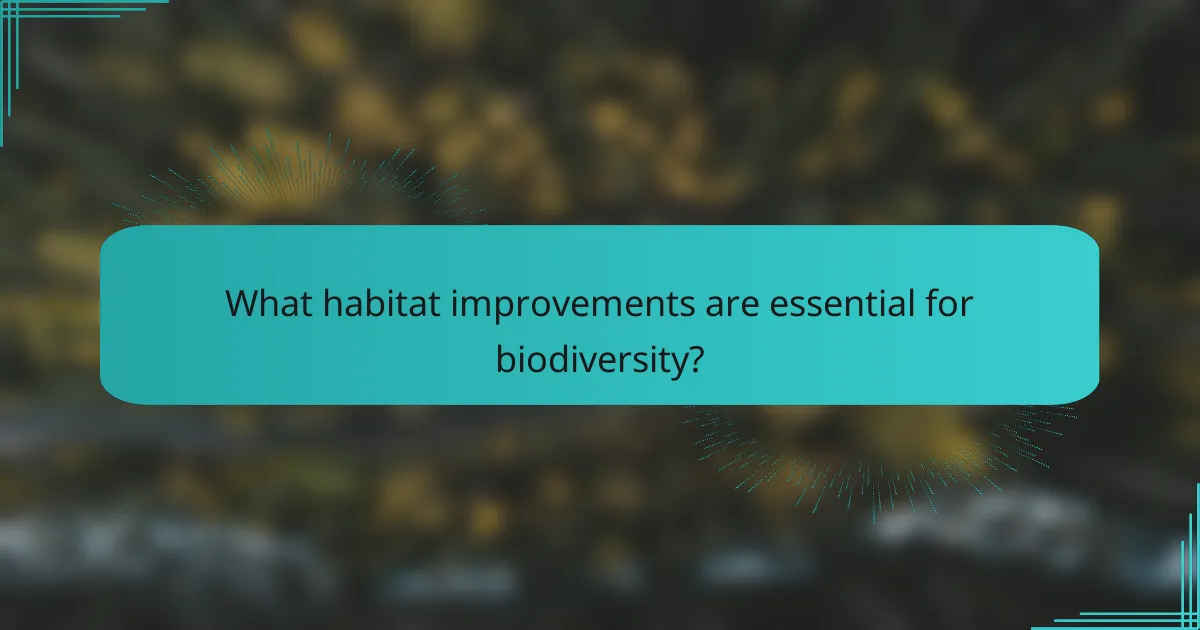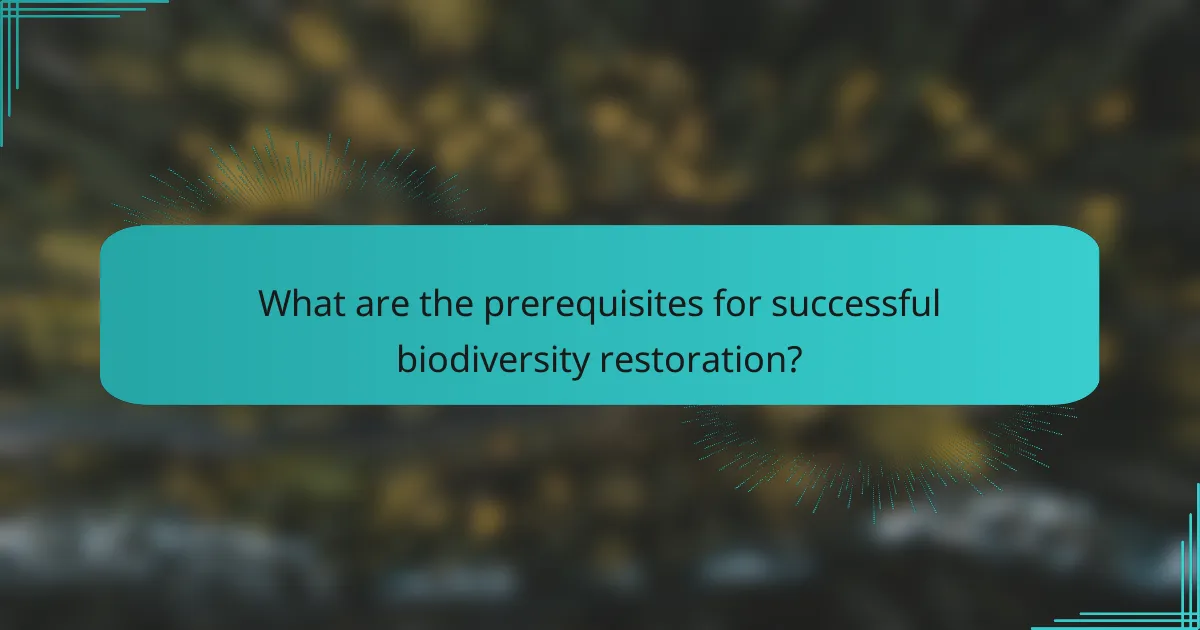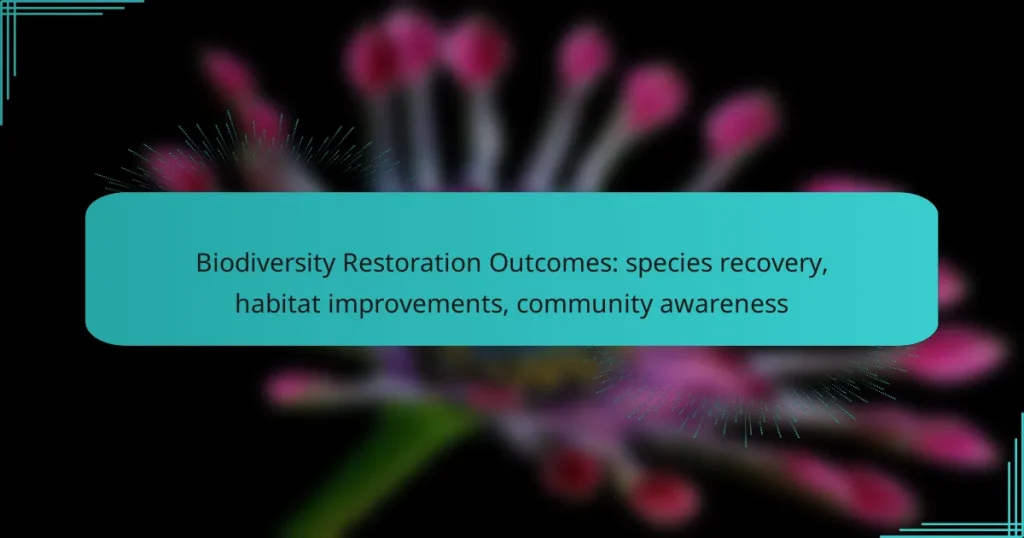Biodiversity restoration in Australia focuses on key outcomes such as species recovery, habitat improvements, and increased community awareness. These efforts are vital for reversing the decline of native species and fostering a culture of conservation. By enhancing ecosystem health and stability, these initiatives not only support wildlife but also benefit human communities through improved ecological functions.

What are the key biodiversity restoration outcomes in Australia?
The key biodiversity restoration outcomes in Australia include species recovery, improvements in ecosystem services, and enhanced community engagement. These outcomes are essential for reversing the decline of native species and habitats while fostering a culture of conservation among local communities.
Species recovery in native habitats
Species recovery in native habitats focuses on restoring populations of endangered and threatened species. This can involve habitat restoration, captive breeding programs, and the removal of invasive species that threaten native flora and fauna.
For example, the recovery of the Eastern Curlew has been supported through habitat protection along migratory routes, demonstrating the effectiveness of targeted conservation efforts. Effective recovery strategies often require collaboration among government agencies, non-profits, and local communities.
Improvements in ecosystem services
Improvements in ecosystem services refer to the benefits that healthy ecosystems provide, such as clean air, water filtration, and soil fertility. Restoration projects can enhance these services by rehabilitating degraded landscapes and promoting biodiversity.
In Australia, initiatives like reforestation and wetland restoration have shown significant improvements in water quality and carbon sequestration. These enhancements not only support wildlife but also contribute to the well-being of human populations by ensuring sustainable resources.
Enhanced community engagement
Enhanced community engagement is crucial for the success of biodiversity restoration efforts. Involving local communities fosters a sense of ownership and responsibility towards conservation initiatives, leading to more sustainable outcomes.
Programs that educate and involve residents, such as citizen science projects and local conservation groups, have proven effective. These initiatives encourage public participation and raise awareness about the importance of biodiversity, ultimately leading to stronger community support for environmental policies and practices.

How does species recovery impact ecosystems?
Species recovery plays a crucial role in enhancing ecosystem health and stability. When species populations rebound, they contribute to the balance of their habitats, leading to improved ecological functions and resilience.
Restoration of food webs
The recovery of species directly influences food webs, which are networks of predator-prey relationships within an ecosystem. As species return, they help restore these interactions, ensuring that energy flows and nutrient cycling occur effectively. For example, the reintroduction of a predator can control herbivore populations, allowing vegetation to thrive and supporting overall biodiversity.
In practical terms, restoring food webs can lead to healthier ecosystems that are better equipped to withstand environmental changes. Conservation efforts should focus on key species that serve as ecological keystones, as their presence can significantly enhance the stability of the entire food web.
Increased genetic diversity
Species recovery often results in increased genetic diversity, which is vital for the adaptability and resilience of populations. A diverse gene pool allows species to better cope with diseases, climate change, and habitat alterations. For instance, plants with varied genetic traits may be more resilient to pests and environmental stressors.
To promote genetic diversity, conservation strategies should prioritize the protection of various habitats and the establishment of wildlife corridors. These measures facilitate gene flow between populations, enhancing their overall health and sustainability. Engaging local communities in these efforts can also raise awareness and support for biodiversity initiatives.

What habitat improvements are essential for biodiversity?
Essential habitat improvements for biodiversity include creating interconnected ecosystems and restoring natural environments. These enhancements support species recovery and promote ecological balance, ultimately benefiting both wildlife and human communities.
Creation of wildlife corridors
Wildlife corridors are vital for allowing animals to move safely between habitats, which is crucial for genetic diversity and population stability. These corridors can be as simple as narrow strips of vegetation or more complex networks that connect larger habitats.
When designing wildlife corridors, consider the types of species that will use them and the landscape features they need to traverse. For example, corridors should be wide enough to accommodate various species and include natural cover to protect them from predators.
Common pitfalls include neglecting to monitor the effectiveness of these corridors after implementation. Regular assessments can help identify areas for improvement and ensure that wildlife can effectively use these pathways.
Restoration of wetlands
Wetland restoration is crucial for enhancing biodiversity as these ecosystems provide essential services such as water filtration, flood control, and habitat for numerous species. Restoring wetlands can involve re-establishing natural water flow, removing invasive species, and replanting native vegetation.
When restoring wetlands, it is important to consider the local hydrology and soil types to ensure that the restoration efforts are sustainable. Engaging local communities in the restoration process can also foster stewardship and increase awareness of the importance of wetlands.
Effective restoration projects often include monitoring and adaptive management strategies to respond to changes in the ecosystem. This approach helps ensure that the restored wetland continues to support diverse species and functions effectively over time.

How can community awareness be increased for biodiversity?
Increasing community awareness for biodiversity involves engaging local populations through education and active participation in conservation efforts. By fostering a deeper understanding of biodiversity’s importance, communities can take meaningful actions to protect their natural environments.
Educational programs in schools
Implementing educational programs in schools is a vital step in raising awareness about biodiversity. These programs can include interactive lessons on local ecosystems, field trips to nature reserves, and projects that encourage students to observe and document local wildlife.
Schools can partner with local conservation organizations to provide resources and expertise. This collaboration can enhance the curriculum and create opportunities for students to engage in hands-on conservation activities, fostering a sense of responsibility towards their environment.
Community-led conservation initiatives
Community-led conservation initiatives empower local residents to take charge of biodiversity efforts in their areas. These initiatives can range from organizing clean-up days in local parks to creating community gardens that support native species.
Encouraging participation through workshops and volunteer programs can help build a strong community network focused on conservation. Additionally, sharing success stories from these initiatives can inspire others to join in and adopt similar practices, amplifying the impact on local biodiversity.

What are the prerequisites for successful biodiversity restoration?
Successful biodiversity restoration requires a combination of stakeholder collaboration, adequate funding, and effective resource allocation. These elements ensure that restoration efforts are well-planned, supported, and sustainable over time.
Stakeholder collaboration
Engaging various stakeholders, including local communities, government agencies, and non-profit organizations, is crucial for effective biodiversity restoration. Collaboration fosters shared goals and enhances the commitment to conservation efforts.
To facilitate stakeholder collaboration, establish clear communication channels and involve all parties in decision-making processes. Regular meetings and workshops can help build trust and ensure that everyone’s perspectives are considered.
Funding and resource allocation
Securing adequate funding is essential for implementing biodiversity restoration projects. This can come from government grants, private donations, or partnerships with businesses that support environmental initiatives.
When allocating resources, prioritize projects based on their potential impact and feasibility. Consider creating a budget that includes costs for materials, labor, and ongoing maintenance to ensure long-term success. Additionally, leveraging local resources can reduce costs and enhance community involvement.

What metrics are used to measure biodiversity restoration success?
Metrics for measuring biodiversity restoration success primarily focus on species recovery, habitat improvements, and community engagement. These metrics help assess the effectiveness of restoration efforts and guide future actions.
Species population counts
Species population counts are essential for evaluating the recovery of specific flora and fauna in restored areas. This involves monitoring the number of individuals within key species over time to determine trends in population growth or decline.
Common methods include field surveys, remote sensing, and citizen science initiatives. For instance, tracking bird populations in a restored wetland can reveal the success of habitat improvements, with increases indicating positive outcomes.
Habitat quality assessments
Habitat quality assessments evaluate the condition of ecosystems and their ability to support diverse species. This includes measuring factors such as vegetation cover, soil health, and water quality, which are critical for sustaining wildlife.
Tools like the Habitat Quality Index (HQI) can provide a standardized way to assess these factors. Regular assessments help identify areas needing further restoration, ensuring that habitats remain viable for the species they support.

What are the emerging trends in biodiversity restoration?
Emerging trends in biodiversity restoration focus on species recovery, habitat improvements, and increasing community awareness. These trends emphasize collaborative approaches, innovative techniques, and the integration of local knowledge to enhance ecological resilience.
Species Recovery
Species recovery involves strategies aimed at restoring populations of endangered or threatened species. Techniques such as captive breeding, habitat restoration, and reintroduction into their natural environments are commonly employed. For example, the reintroduction of wolves in Yellowstone National Park has significantly impacted the ecosystem, demonstrating the importance of apex predators.
Monitoring and adaptive management are crucial in species recovery efforts. Regular assessments help track population changes and the effectiveness of restoration strategies. Engaging local communities in these efforts can enhance success rates, as they often possess valuable ecological knowledge.
Habitat Improvements
Habitat improvements focus on restoring and enhancing ecosystems to support diverse species. This can include reforestation, wetland restoration, and the removal of invasive species. For instance, restoring mangrove forests can protect coastlines and provide critical habitat for various marine species.
Implementing sustainable land-use practices is essential for long-term habitat improvement. Techniques such as agroforestry and permaculture can help balance agricultural needs with biodiversity conservation. Collaboration with local stakeholders ensures that habitat restoration aligns with community needs and ecological goals.
Community Awareness
Community awareness plays a vital role in biodiversity restoration by fostering public engagement and support for conservation initiatives. Educational programs, workshops, and community events can raise awareness about local biodiversity and the importance of restoration efforts. Involving community members in restoration projects can empower them and build a sense of ownership.
Effective communication strategies are necessary to convey the benefits of biodiversity restoration. Highlighting success stories and tangible outcomes can motivate communities to participate actively. Utilizing social media and local networks can amplify awareness and encourage broader participation in conservation efforts.


